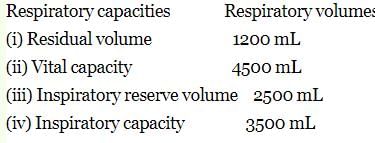Test: Mechanism of Breathing (NCERT) - NEET MCQ
15 Questions MCQ Test NCERTs at Fingertips: Textbooks, Tests & Solutions - Test: Mechanism of Breathing (NCERT)
1. Which instrument is used for measuring volume of air involved in breathing?
A person breathing normally at rest, takes in and expels approximately half a litre of air during each respiratory cycle. This is called
Listed below are four respiratory capacities (i-iv) and four jumbled respiratory volumes of a normal human adult

Which one of the following is the correct matching of two capacities and volumes?
Which of the following changes occur in diaphragm and intercostal muscles when expiration of air takes place?
Which of the following statements about the mechanism of ventilation/breathing is incorrect?
Which of the following sequence is correct to invite inspiration?
(i) the contraction of external intercostal muscles raises the ribs and sternum
(ii) Volume of thorax increases in the dorso-ventral axis
(iii) intrapulmonary pressure decreases
(iv) Diaphragm contraction
(v) Air rushes into lungs
(vi) Volume of thorax increases in the anterior-posterior axis
Select the sequence of steps in Respiration.
(A) Diffusion of gases (O2 and CO2) across alveolar membrane.
(B) Diffusion of O2 and CO2 between blood and tissues.
(C) Transport of gases by the blood
(D) Pulmonary ventilation by which atmospheric air is drawn in and CO2 rich alveolar air is released out.
(E) Utilisation of O2 by the cells for catabolic reactions are resultant release of CO2
Choose the correct answer from the options given below :
Given below are two statements : one is labelled as Assertion (A) and the other is labelled as Reason (R).
Assertion (A) : A person goes to high altitude and experiences "Altitude Sickness" with symptoms like breathing difficulty and heart palpitations.
Reason (R) : Due to low atmospheric pressure at high altitude, the body does not get sufficient oxygen.
In the light of the above statements, choose the correct answer from the options given below :
Consider the following statements each with two blanks.
(i) Actually, only about ___(1)___ml of air enters the lung alveoli for the exchange of gases. The remaining fills the respiratory passage and is termed ___(2)___.
(ii) The amount of air which one can inhale with maximum effort and also exhale with maximum effort is termed as ___(3)___. It is about ___(4)___ in normal adult person.
(iii) During normal quiet breathing, on an average, approximately _____(5)_____ ml of air is inspired or expired by adult human male in each breath. It is termed as __(6)__ volume.
Which of the following options gives the correct fill-ups for the respective blank numbers from (1) to (6) in the above statements?
Identify the region of human brain which has pneumotaxic centre that alters respiratory rate by reducing the duration of inspiration.
Which of the following statements are correct with respect to vital capacity?
(a) It includes ERV, TV and IRV
(b) Total volume of air a person can inspire after a normal expiration.
(c) The maximum volume of air a person can breathe in after forced expiration.
(d) It includes ERV, RV and IRV.
(e) The maximum volume of air a person can breath out after a forced inspiration.
Choose the most appropriate answer from the options given below :
The inspiratory reserve volume + tidal volume + expiratory reserve volume is the same as
Under normal physiological conditions in human being every 100 ml of oxygenated blood can deliver ____________ ml of O2 to the tissues.
|
257 docs|234 tests
|



















